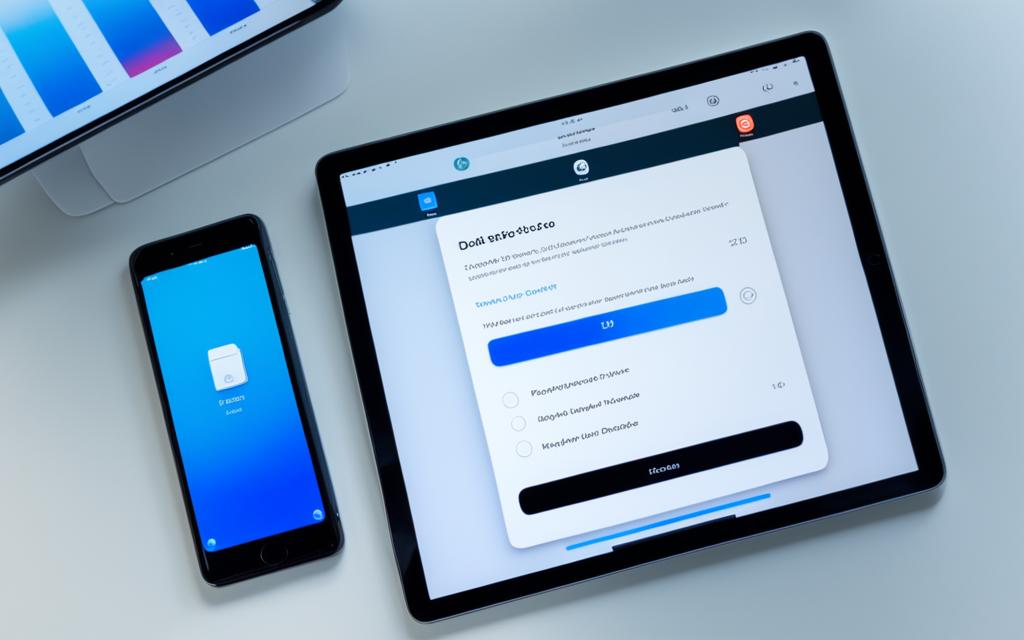Table of Contents
Backing up your iPad to an external hard drive is key for keeping your important data safe. There’s always a risk of losing information due to device problems or mistakes like accidental deletions. A physical hard drive gives you extra security compared to just using the cloud. While iPads usually use iCloud or a computer connection for backups, those methods might not work for everyone. Learning to back up your iPad properly means your data stays safe. You’ll be more at ease knowing your digital memories and crucial info are protected. For more on how to do these backups, check out this detailed guide here.
Key Takeaways
- Regularly backup your iPad to an external hard drive to protect your critical information.
- Consider both native and alternative backup solutions to find what best suits your needs.
- Utilising tools such as iTunes, Finder, and third-party apps can complement your backup strategy.
- Maintaining multiple backup versions is vital for preventing data loss.
- Explore USB connections for backing up without a computer for added flexibility.
Understanding the Importance of Backup for Your iPad
Your iPad holds priceless data, like vital documents and cherished memories. Backups are key to protecting this data. Without them, losing your data can have permanent impact. It’s critical to have a strong backup strategy to keep your digital treasures safe.
Protecting Critical Data
iPads are central to many daily tasks, but this increases the risk of data loss. Think about all the information stored: photos, contacts, app settings. It shows why backing up is so important. iCloud offers 5GB of free storage for each Apple ID, enabling easy data backups4. For those needing more space, Apple has options to buy additional storage4.
Choosing the Right Backup Strategy
Finding the right backup plan is crucial. iCloud backups happen automatically with Wi-Fi, keeping data updated without you needing to do anything4. You can also choose computer backups which depend on your Mac’s or PC’s available storage5. Each backup method covers most of your iPad’s data and settings, but not everything5.
Tools like Acronis True Image offer even more backup options. They let you tailor your backup solutions whether on a computer or in the cloud4. By choosing the right backup strategy, you ensure your iPad’s data is safe from loss. This brings a sense of security and protects the longevity of your digital content.
| Backup Method | Storage Capacity | Key Features |
|---|---|---|
| iCloud | 5GB free (up to 14TB with Apple One Premier) | Automatic backups, easy restoration, real-time syncing |
| Computer | Dependent on local storage | Comprehensive data inclusion, manual control |
| Third-Party Software | Varies | Customisable options, ease of use |
How to Backup an iPad to an External Hard Drive
Backing up your iPad to an external hard drive safeguards your files. You can use iTunes on Windows or Finder on Mac for the backup. These simple steps will keep your important data safe.
Using iTunes for Backup on Windows
iTunes on Windows lets you back up iPad data easily. It usually saves backups on the C Drive, which might fill up quickly6. To save space, you can move these backups to an external drive with a symbolic link in Command Prompt. This way, you won’t run out of space on your system drive. Here’s how to do it:
- Connect your iPad to your Windows PC using a USB cable.
- Open Command Prompt as an administrator.
- Enter the command to create a symbolic link to your external hard drive.
Consider using FoneTool for easier backup management6. It allows for selective backups of photos, videos, and messages straight to your external hard drive. This gives you more control over what you back up.
Using Finder for Backup on Mac
For Mac users, Finder makes backing up an iPad straightforward, especially on macOS 10.15 or newer. Here’s the simple process:
- Connect your iPad to your Mac with a USB cable.
- Open Finder and select your iPad under Locations.
- Opt to back up all your iPad data on the external hard drive.
Finder provides secure data storage but, unlike iTunes, it doesn’t limit backups to the system drive. The FileBrowser app is another great option. It helps move files between your iPad and any external drive with ease1.
| Backup Method | Platform | Key Features |
|---|---|---|
| iTunes | Windows | Direct backup but may face storage issues on C Drive. |
| Finder | Mac | Direct backups to external drives, seamless integration. |
| FoneTool | Windows | Selectively backup data, user-friendly interface. |
| FileBrowser | Both | Facilitates file transfers and backups to various storage options. |
Alternative Methods to Backup iPad Data
Storing your iPad’s data safely is vital in our digital world. iCloud is a popular option, but there are other ways too. These methods let you choose what’s best for your data needs.
A Quick Overview of iCloud Backups
The iCloud backup offers an easy way to keep your files safe. It starts with 5 GB of free storage. You can buy more, up to 12 TB7. It backs up your photos, documents, and apps daily when your iPad is charged8. This ensures your data is safe without you having to do a thing.
Utilising Third-Party Applications
Looking beyond iCloud, many third-party apps give powerful backup options. One such app, FileBrowser Professional, lets you save files to external drives. This means you’re not just stuck with cloud services. Other tools like UltFone iOS Data Manager make moving photos to a PC easy. They also change HEIC files to JPGs in big groups9. These apps do more than usual backup methods and make managing your files simpler.
| Backup Method | Features | Pros | Cons |
|---|---|---|---|
| iCloud | Automatic daily backups, integrates well with Apple devices | Convenient, minimal user involvement required | Limited free storage, additional purchases required for more space |
| FileBrowser Professional | Direct backup to external drives, no need for cloud services | Flexible data management, faster access to files | May require additional setup and learning curve |
| UltFone iOS Data Manager | Easily transfers files, supports multiple formats | Comprehensive backup solutions, facilitates media management | Requires installation of third-party software |
Steps to Backup iPad Photos to an External Hard Drive
Backing up iPad photos on an external drive is key to keeping your memories safe. Several methods are out there, so you can pick what’s best for you. Using a USB-to-Locking adapter to link your iPad and the drive directly is an easy way. This method is straightforward and saves you the cost of using a computer. It’s great for quickly backup iPad photos.
To start, plug the external drive into your iPad with the adapter. Then, go to the Files app to see your drive listed. Just drag and drop the photos you want to move. This method lets you manage your external hard drive photos simply and effectively.
If you like using a computer, plug your iPad in with a USB. Then open iTunes or Finder, based on what system you have. When your device shows up, pick the photos to backup, and select your external drive as the place to save them. This could take around 15 minutes or more6. However, be aware that iTunes might delete files when backing up10.
If you find these methods hard, third-party apps like MobiKin Assistant for iOS can help. This program lets you see your files before transferring. It makes backup and managing data easy10.
| Method | Description | Pros | Cons |
|---|---|---|---|
| USB-to-Lightning Adapter | Direct transfer from iPad to external hard drive | Simplifies the process, cost-effective | Requires specific hardware setup |
| iTunes/Finder | Backup via computer | Allows for comprehensive backup | May erase data and complex settings |
| Third-party Software | Apps like MobiKin for easier backup | User-friendly features | Possible costs associated |
Knowing about these methods helps keep your external hard drive photos safe. It means your pictures are secure for years to come.
Conclusion
It’s crucial to back up your iPad regularly for effective data protection. You can use iTunes or Finder for backups on an external drive. Or, you might prefer the ease of iCloud and third-party apps. These methods make sure your data is safe from loss.
People have different preferences when it comes to backup methods. Some like a mix of cloud services and external drives. Online forums are full of advice on backup strategies. They stress that having solid backup routines is key to digital security11.
In today’s digital world, protecting your data is a must. By keeping a regular backup schedule, you keep your information safe. This is true even if you change devices or lose data. So, you can concentrate on what’s most important.
FAQ
Why should I back up my iPad to an external hard drive?
Backing up your iPad to an external drive is key for keeping your data safe. It helps protect important documents and precious memories from being lost.
What are the advantages of using an external hard drive for backups compared to cloud solutions?
Hard drives let you manage your data with ease without needing the internet. They offer a tangible backup without the ongoing costs of cloud storage.
How can I back up my iPad using iTunes on a Windows computer?
Just connect your iPad to your PC using USB, then fire up iTunes. Select your device, hit the “Backups” area, and choose “This Computer.” Hit “Back Up Now” to start.
Can I use Finder to back up my iPad on a Mac?
Indeed, connect your iPad to your Mac and open Finder. Pick your device in the sidebar. In “Backups”, opt for “Back up all data on your iPad to this Mac.” Then click “Back Up Now.”
Is it possible to back up my iPad photos directly to an external hard drive?
Yes! Plug your hard drive into your iPad with a USB-to-lightning adapter. You can then manually move your photos. Alternatively, back them up via your computer using iTunes or Finder.
How can I set up automatic iCloud backups for my iPad?
Go to “Settings” on your iPad and tap your Apple ID. Choose “iCloud”, then “iCloud Backup”. Turn it on for daily auto backups when you charge your iPad.
Are there any recommended third-party applications for backing up my iPad data?
Sure, FileBrowser Professional makes it easy to back up files to external drives. It’s a great way to manage your data without cloud services.
Source Links
- https://discussions.apple.com/thread/255063546 – How can I backup my ipad to an external h…
- https://mobiletrans.wondershare.com/ipad-transfer/backup-ipad-to-external-hard-drive.html – How to Backup iPad to an External Hard Drive with/without a PC [2024]
- https://www.ubackup.com/phone-backup/backup-ipad-to-external-hard-drive.html – How to Backup iPad to External Hard Drive on PC/Mac
- https://www.acronis.com/en-us/blog/posts/ipad-backup/ – How to backup iPad? The Ultimate Guide for 2024
- https://support.apple.com/en-us/108771 – Backup methods for iPhone, iPad, and iPod touch – Apple Support
- https://www.ubackup.com/phone-backup/backup-ipad-to-external-hard-drive-windows.html – How to Backup iPad to External Hard Drive with/without iTunes
- https://www.lifewire.com/back-up-your-ipad-1999864 – 3 Ways to Back Up Your iPad
- https://readdle.com/move-backups-external-hard-drive-tutorial – Readdle
- https://www.ultfone.com/ios-manager/backup-ipad-to-external-drive.html – [3 Ways] Backup iPad to External Drive
- https://www.mobikin.com/idevice/transfer-data-from-ipad-to-external-hard-drive.html – 4 Ways to Back Up iPad to External Drive [Easy & Quick]
- https://talk.macpowerusers.com/t/the-results-are-in-conclusion-1-month-ipad-only-experiment-with-new-m4-ipad-pro/37298?page=2 – !The Results are In-Conclusion! 1 Month iPad Only Experiment with New M4 iPad Pro












